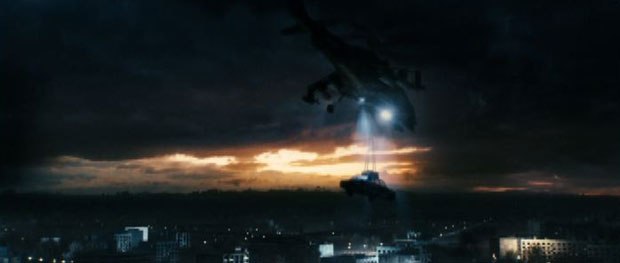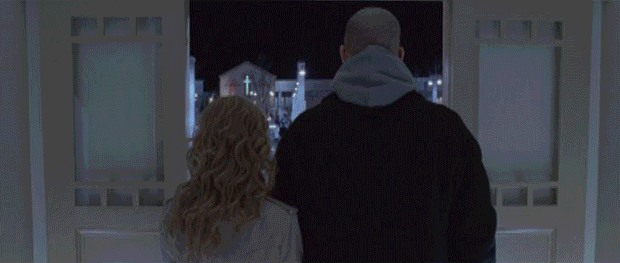Alain Bielik speaks with Buf Compagnie about the variety of vfx that it created for Babylon A.D.
In 1999, French (now Canadian) author Maurice Dantec published an influential science-fiction book called Babylon Babies. It tells the story of Hugo Toorop, a mercenary who is hired to escort a mysterious young woman across a post apocalyptic Europe in the year 2013. During their perilous journey, Toorop discovers that the woman is carrying a secret that could change the fate of the whole human race...
Mathieu Kassovitz (Gothika) has now turned the book into a gritty sci-fi epic, Babylon A.D. (now playing from Fox). The French director worked on the script for months, trimming it down, changing characters and making it possible for the 600-page story to be told in less than two hours. Two of the main alterations were changing the name of the woman from Marie to Aurora, because the original first name was too "obvious," and modifying the title from to Babylon A.D., partly because Kassovitz was worried that American audiences would understand the original title as The Babes from Babylon...
The movie was the director's first large-scale vfx project ever. Very early on, even before the script was completed, he consulted with French digital effects powerhouse Buf Compagnie. Many concepts and ideas were discussed with Founder and Manager Pierre Buffin and his team. "At that time, I think he hadn't even started to write the script," Buffin remembers. "Our discussions were based on the book itself. It was the first time that we worked with Mathieu. We found that he knew what he wanted, but at the same time, he proved to be very open to solutions and suggestions. During the following months, we managed to establish a trustful relationship and to install a fruitful and creative dialogue. The movie ended up being quite complex, not exactly in terms of technical challenges, but in terms of the variety of effects that we had to achieve. It required a great deal of highly qualified artists and a huge amount of visual research. Most of the real challenges involved creating the final battle sequence on the plaza."
A Unique Approach
The team at Buf included VFX Supervisor Stephane Ceretti, VFX Producer Aurelia Abate and New York VFX Unit Director Sebastien Drouin. The company ended up creating some 592 vfx shots, a huge amount by French standards. The project lasted more than a year and involved up to 100 artists. As usual, the company created the shots with a very atypical pipeline. Instead of taking a shot from department to department, with new artists carrying on the work initiated by others, Buf artists would often single-handedly tackle a shot from initial design to final composite. "Our philosophy is to work with multi-talent artists who are able to take a shot from start to completion," Buffin remarks.
The process started by previsualizing the major sequences of the movie. The animatics, as well as all the effects work, were created using a variety of proprietary software. "We did a significant amount of previs, both during pre-production and principal photography," Buffin notes. "We had a team on set to supervise the shoot everyday. Our photographers were there to document and photograph all the set-ups that would later require visual effects. However, the production team experienced serious difficulties and delays during the shoot, which led Mathieu to reconsider his approach to some of the sequences. Due to those changes, the previs work was ultimately never used."
Part of Buf's assignment included the creation of elaborate environments. One of them was a night view of the city that Toorop flies above while comfortably seated in a car being carried by a helicopter. The car was filmed hung below a crane and lit by a powerful light beam from above. Then, Buf connected the live-action car to a CG helicopter and added a 3D environment underneath. "The New York sequence required more extensive work," Buffin says. "Sebastien Drouin was the second unit director on this project. He flew to New York and shot helicopter plates of the city at night. Then, we enhanced those shots, adding many new 3D buildings and inserting multiple giant animated billboards. Since there were so many billboards, it would have required a massive effort to design and animate individual ads for each one of them. So, we created every ad that appeared in the foreground, and for the background, Mathieu had the idea to launch a contest. Production asked freelancers to create original fictitious video ads for the movie, under specific technical requirements. We ended up with enough quality material to animate all those background billboards."
The Prague sequence also featured a combination of live-action plates and CG augmentation in the city background. But the real challenge was enhancing the bombing that takes place in front of a railway station. When the bomb detonates, a huge cloud of smoke appears while the market stands are shattered and victims are catapulted in the air. It was one of the few sequences for which Buf had to create digital characters. To animate them, the studio used its trademark Video Motion Capture system. The process is not motion capture per say, as the performers do not wear any kind of marker. Instead, they are filmed by a series of video cameras. Using this multiple angle footage, animators are able to manually reproduce the performance on a digital character via keyframe animation. Buffin has always thought that, in terms of animation, creative freedom was more important than capturing a movement at once. The system was used with great success on Arthur and the Minimoys.
"We first photographed the extras in costume in Leonardo Da Vinci's famous Vitruvian Man pose," sequence supervisor Antoine Deschamps says. "We used those images to texture our digital characters. Then, we then put them in place and submitted them to a powerful force that was synchronized with the explosion. Using dynamics, we animated them being projected in the air. We also added debris flying around and a ring of dust on the ground. The market stands themselves were not retouched, nor was the explosion. The whole set was rigged with wires, so that when the bomb detonated, all the elements were mechanically pulled away from the explosion."
Extreme Slow Motion
The final sequence features an explosion that proved to be far more complex to create. A rocket is fired at Aurora, but instead of being blown apart by the blast, the young woman appears miraculously unaffected even though all hell breaks loose around her. Knowing this was THE key moment of the whole story, Kassovitz opted to show the action in ultra slow motion, with the camera circling actress Melanie Thierry while the plaza slowly disintegrated around her. This massive shot was the most complex single effect of the movie for Buf.
"The challenge was that we had to see the explosion from the inside, with all the successive actions and reactions, in an extremely slow motion," Co-Sequence Supervisor Xavier Allard recalls. "The second part of the challenge involved creating in CG the destruction, in ultra slow motion again, of the whole environment. Last but not least, because of the nature of the camera movement, we had to recreate Melanie Thierry digitally for the entire length of the shot. We started by reconstructing the environment via photogrammetry. Then, we filmed Melanie in front of a greenscreen with her hair flying around while the camera was circling her at 360°. We then inserted her in the environment."
Adds Co-Sequence Supervisor Djelloul Bekri, "For the explosion, we opted not to use digital fire, as it is very difficult to create convincing flames in 3D, and even more difficult to control them. Since we had to show the explosion from its very early stages, control was of paramount importance. So, we shot a real explosion, using four different cameras, including two shooting at very high speed. Those images were then projected onto a series of animated 3D domes representing the expanding volume of the explosion. It allowed us to perfectly control the look of the fire, its speed, its volume, its density, etc. We then added many layers of live- action smoke elements, CG smoke and dust."
Besides the explosion itself, the other tricky aspect of the shot was animating the pavement being ripped apart by the blast. Buf modeled and textured many different concrete pieces to build up a library. Due to the great number of elements, the database needed to be highly optimized for the artists to handle them with ease. Animation was also a real challenge as the pavement elements needed to break apart and fly away in a realistic way, but also in a visually pleasing manner.
The plaza was also featured earlier in the sequence via an extensive power of 10 shot. "We start with the camera high above the Earth and dive down until we ultimately only see Vin Diesel's eye," Buffin explains. "We used a succession of six different matte paintings to create the shot."
Going North
Besides the urban sequences, Buf also worked on an intricate sequence set in the Arctic. The action involves a chase between snow bikes and a drone, and no less than a nuclear submarine. The drone was created in CG by reproducing a miniature built by production. The submarine, though, was a full size prop built in a water tank in the backlot of Barrandov Studios in Prague. The submarine set could be raised out of the tank to break the ice surface. To prevent the camera from filming the real environment, the whole set was surrounded by a white cyclorama. White was chosen over blue or green to avoid unnecessary reflections on the snow surface.
"Since the actors all wore dark colors, and since the submarine was very dark too, it was quite simple to do a luminosity key to obtain a clean mask," notes Sequence Supervisor Mathilde Tollec. "We could also insert the environment in a much easier way. The landscape was created by assembling various photographs shot in Sweden. The more complex aspect of the sequence involved adding hundreds of digital extras behind a group of real actors. We created them using the same technique that was employed for the railway station bombing: the actors were photographed in costume in the Vitruvian Man pose, then the textures maps were retouched to create a greater number of characters. After that, we filmed them in VMC to gather movement references. Then, we animated them and inserted them in the scene. We had to be really careful that their behavior precisely matched what the principals were doing. Ultimately, we also added a layer of digital mist to blend all this together and enhance the polar atmosphere."
Except for the in-your-face final explosion shot, most of Buf shots will remain invisible to the audience. Their work needed to blend in with the story as not to take attention away from the character's journey. A journey that the team also took behind the scene as the troubled production took its toll on many crew members. This was not the case in post-production, though, and Buf even benefited from a very long production time. A real luxury at a time when hurried post-production has become the norm.
Alain Bielik is the founder and editor of renowned effects magazine S.F.X, published in France since 1991. He also contributes to various French publications, both print and online, and occasionally to Cinefex. In 2004, he organized a major special effects exhibition at the Musée International de la Miniature in Lyon, France.













